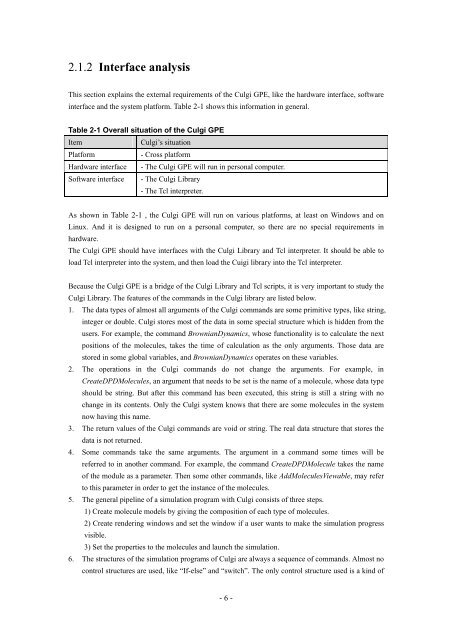Master's Thesis - Computer Graphics and Visualization - TU Delft
Master's Thesis - Computer Graphics and Visualization - TU Delft
Master's Thesis - Computer Graphics and Visualization - TU Delft
You also want an ePaper? Increase the reach of your titles
YUMPU automatically turns print PDFs into web optimized ePapers that Google loves.
2.1.2 Interface analysis<br />
This section explains the external requirements of the Culgi GPE, like the hardware interface, software<br />
interface <strong>and</strong> the system platform. Table 2-1 shows this information in general.<br />
Table 2-1 Overall situation of the Culgi GPE<br />
Item Culgi’s situation<br />
Platform - Cross platform<br />
Hardware interface - The Culgi GPE will run in personal computer.<br />
Software interface - The Culgi Library<br />
- The Tcl interpreter.<br />
As shown in Table 2-1 , the Culgi GPE will run on various platforms, at least on Windows <strong>and</strong> on<br />
Linux. And it is designed to run on a personal computer, so there are no special requirements in<br />
hardware.<br />
The Culgi GPE should have interfaces with the Culgi Library <strong>and</strong> Tcl interpreter. It should be able to<br />
load Tcl interpreter into the system, <strong>and</strong> then load the Cuigi library into the Tcl interpreter.<br />
Because the Culgi GPE is a bridge of the Culgi Library <strong>and</strong> Tcl scripts, it is very important to study the<br />
Culgi Library. The features of the comm<strong>and</strong>s in the Culgi library are listed below.<br />
1. The data types of almost all arguments of the Culgi comm<strong>and</strong>s are some primitive types, like string,<br />
integer or double. Culgi stores most of the data in some special structure which is hidden from the<br />
users. For example, the comm<strong>and</strong> BrownianDynamics, whose functionality is to calculate the next<br />
positions of the molecules, takes the time of calculation as the only arguments. Those data are<br />
stored in some global variables, <strong>and</strong> BrownianDynamics operates on these variables.<br />
2. The operations in the Culgi comm<strong>and</strong>s do not change the arguments. For example, in<br />
CreateDPDMolecules, an argument that needs to be set is the name of a molecule, whose data type<br />
should be string. But after this comm<strong>and</strong> has been executed, this string is still a string with no<br />
change in its contents. Only the Culgi system knows that there are some molecules in the system<br />
now having this name.<br />
3. The return values of the Culgi comm<strong>and</strong>s are void or string. The real data structure that stores the<br />
data is not returned.<br />
4. Some comm<strong>and</strong>s take the same arguments. The argument in a comm<strong>and</strong> some times will be<br />
referred to in another comm<strong>and</strong>. For example, the comm<strong>and</strong> CreateDPDMolecule takes the name<br />
of the module as a parameter. Then some other comm<strong>and</strong>s, like AddMoleculesViewable, may refer<br />
to this parameter in order to get the instance of the molecules.<br />
5. The general pipeline of a simulation program with Culgi consists of three steps.<br />
1) Create molecule models by giving the composition of each type of molecules.<br />
2) Create rendering windows <strong>and</strong> set the window if a user wants to make the simulation progress<br />
visible.<br />
3) Set the properties to the molecules <strong>and</strong> launch the simulation.<br />
6. The structures of the simulation programs of Culgi are always a sequence of comm<strong>and</strong>s. Almost no<br />
control structures are used, like “If-else” <strong>and</strong> “switch”. The only control structure used is a kind of<br />
- 6 -

















